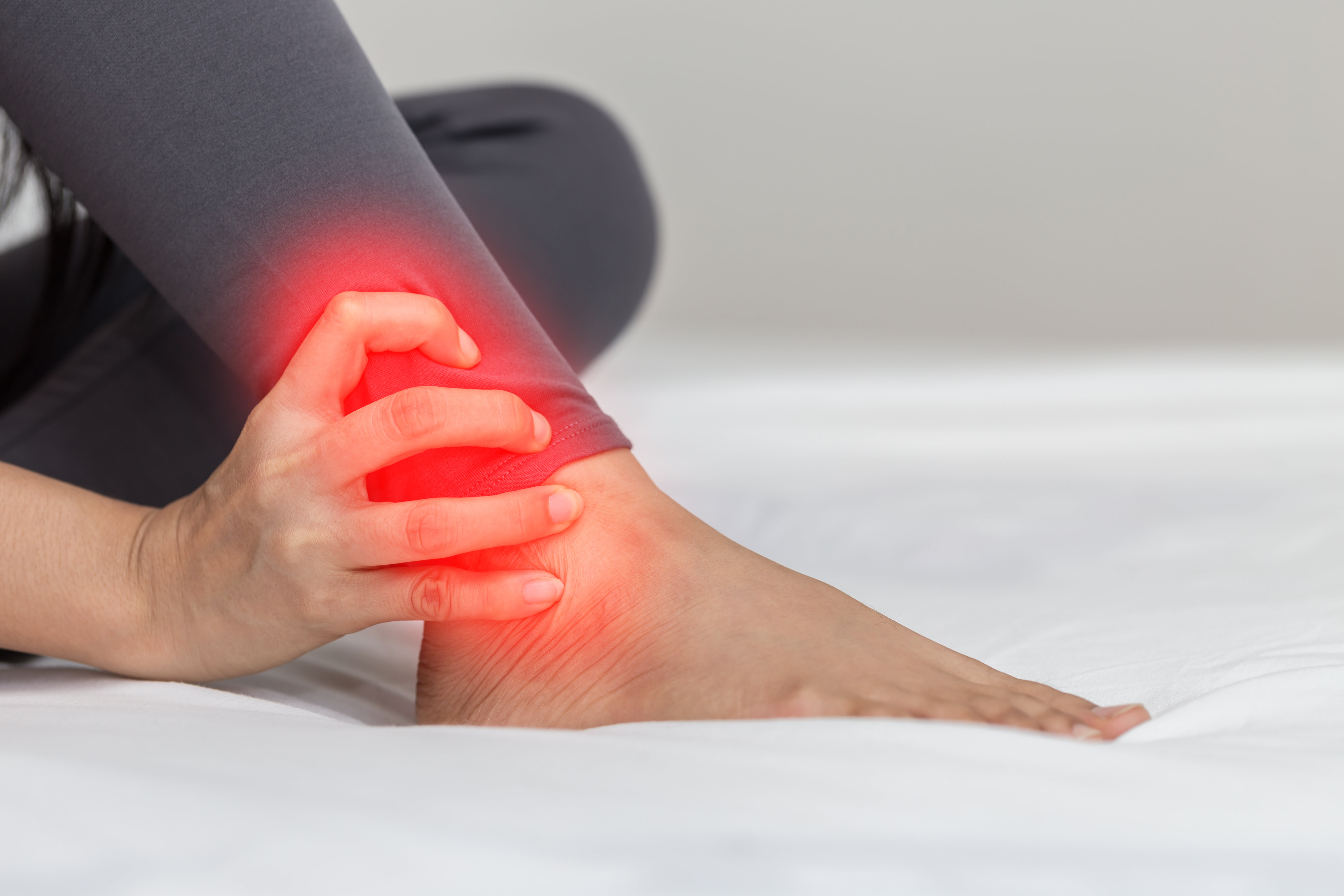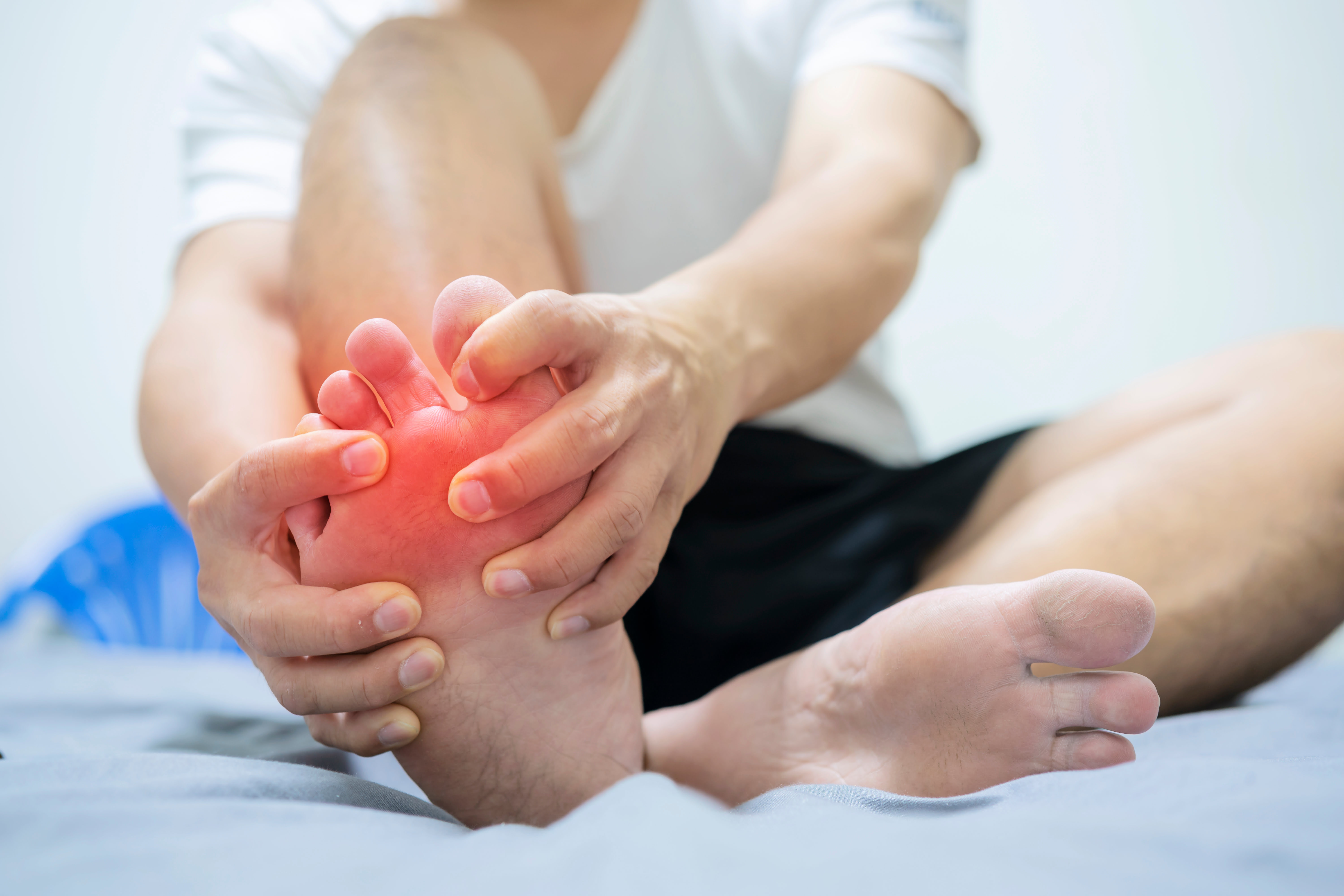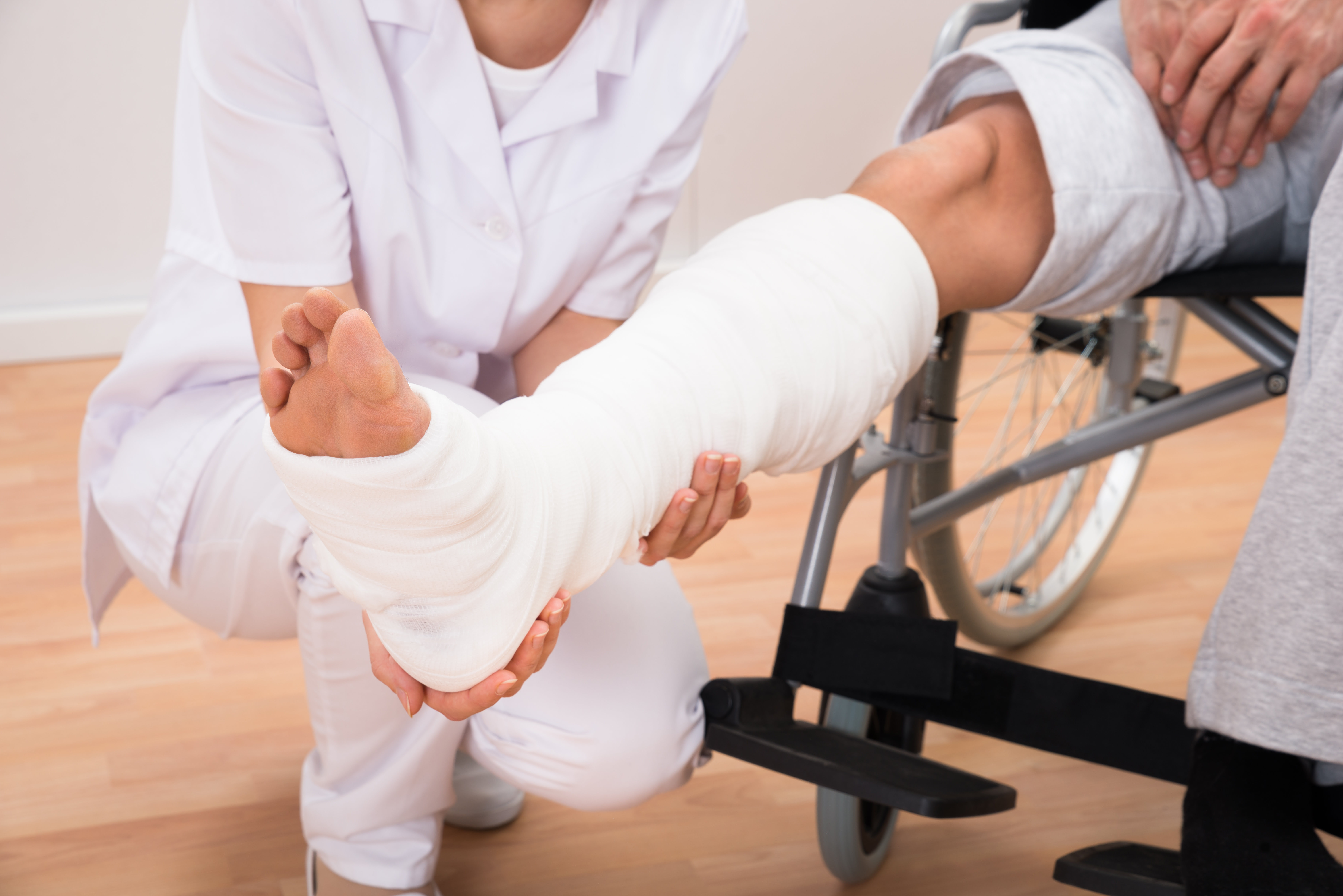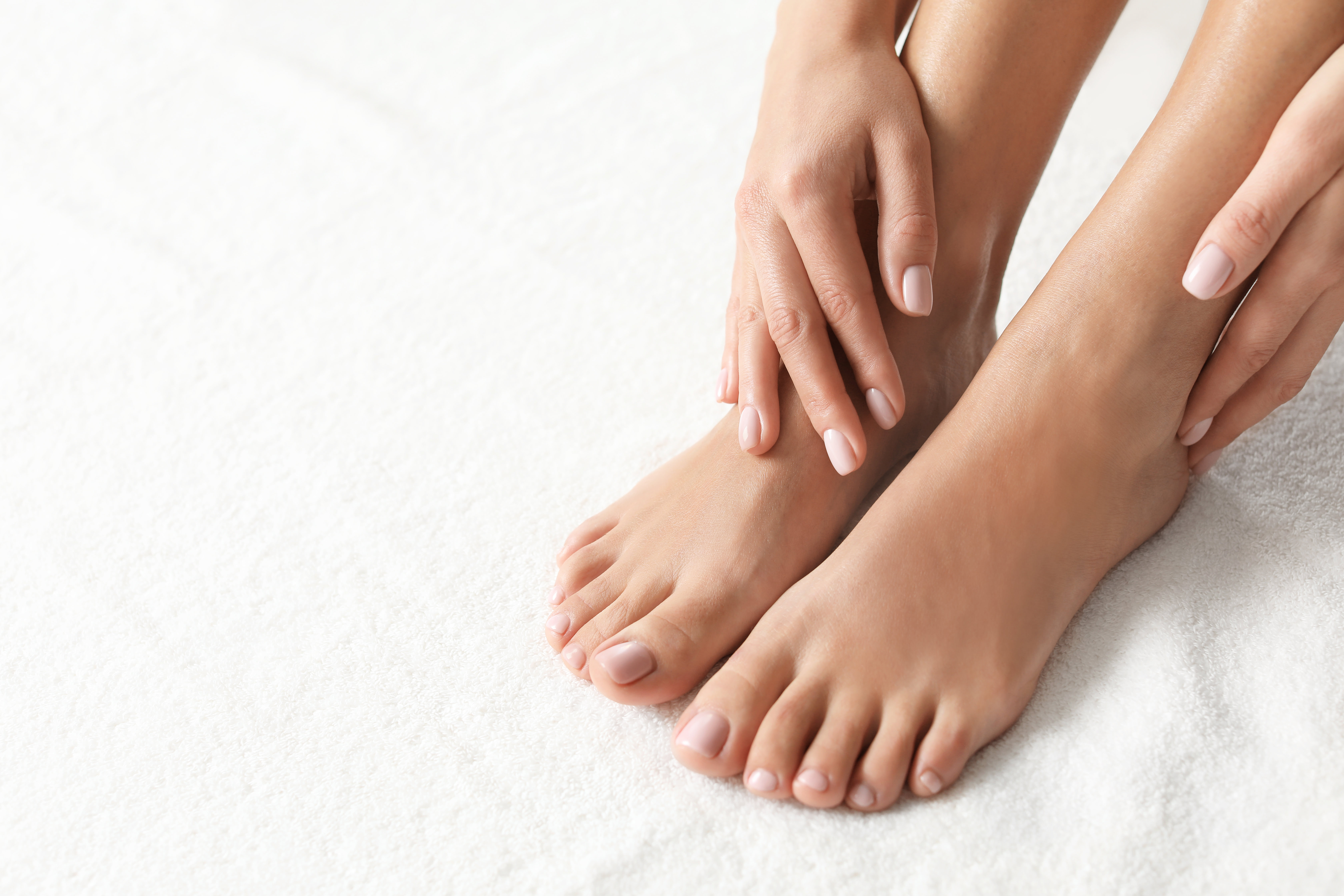Heel Pain

Heel pain is one of the most common problems we treat at EFA. We offer both innovative conservative care and advanced surgical techniques to help you lead an active lifestyle.
Book an AppointmentHeel Pain Q & A
What is the most common cause of heel pain?
The most common cause of heel pain is plantar fasciitis. Pain may be experienced in the morning with the first few steps and sometimes improves with walking. This can be a nagging pain that may last for months without treatment.
What are other common causes of heel pain?
Some of the most common causes of this debilitating condition are:
- Achilles tendonitis
- Haglund's bump
- Bursa
- Nerve entrapment
- Heel spur
What are some treatment options for heel pain?
Treatment options often begin with oral anti-inflammatory medications, stretching exercises, bracing, physical therapy and a steroid injection. Some conditions may be treated with regenerative medicine such as PRP.
Surgical options are reserved in the case of failed conservative treatment. Some procedures we offer include:
- Plantar fascia release (open or endoscopic)
- Achilles tendon debridement
- Resection of the Halund’s bump
- Resection of the Bursa
- Release of nerve entrapment
- Debridement of the heel spur
Sports Medicine

At EFA, we have the ability to provide for all your sports related foot and ankle needs. With advanced technology available in our clinic, we have the ability to diagnose and treat your conditions in house so you can get back to your active lifestyle quicker.
If you are an athlete pain can be a common occurrence however receiving prompt advice and treatment may be pivotal to prevent minor or major injuries
Book an AppointmentSports Medicine Q & A
What are some common foot and ankle sports injuries?
Common types of injuries include:
- Ankle sprains (Acute and Chronic)
- Ankle instability
- Foot and ankle fractures
- Achilles tendon injuries
- Midfoot injuries
- Turf toe
- Shin splints
- Heel pain
What are my treatment options?
Treatment options for sports injuries may depend on the nature of the injury from conservative care to surgical care.
To evaluate the extent of the injury it is essential to obtain diagnostic imaging studies such as X- rays, Magnetic Resonance Imaging (MRI), Computed Tomography (CT) scans and/or Ultrasounds.
Depending on the nature of the injury, treatment options for foot and ankle injuries include:
Conservative Treatment:
- Bracing/immobilization
- Medications
- Injections
- Orthotics
- Physical therapy
- Regenerative medicine
Surgical Treatment:
- Fracture repair
- Ligament repair/reconstruction
- Arthroscopy
- Tendon rebalancing
Foot and Ankle fractures

At EFA, our goal is to provide excellent quality care to expedite your recovery to return to your previous level of activities. Dr. Prasla has extensive training in surgical and non-surgical fracture management from toes to ankles. EFA uses innovative techniques with modern implants to improve your outcome.
Book an AppointmentFoot and Ankle fractures Q & A
What causes foot and ankle fractures?
Traumatic fractures are caused by abnormal forces on normal bone.
This may include:
- Twisting the foot/ankle
- Falls
- Motor vehicle accident
- Sports injuries
What are my treatment options?
Fractures are deemed either stable or unstable, therefore this will determine the treatment options. As a general rule, stable fractures can be treated conservatively, and unstable fractures require surgical fixation to provide stability.
Nonsurgical options include:
- Casting
- Fracture shoe
- CAM boot
Surgical options include:
- Open reduction and internal fixation
- Percutaneous techniques
What is my recovery process like?
The recovery process typically depends on the injury type and treatment plan. At EFA, our goal is to enhance your recovery with early and safe mobilization.
See Dr. Prasla for more information on regenerative medicine options for early recovery.
Bunions

At EFA, we offer advanced solutions to your bunion pain including minimally invasive surgical techniques.
Book an AppointmentBunions Q & A
What is a bunion?
A bunion is a bony bump that forms on the inside of your big toe. This causes the big toe to move toward your second toe which results in the skin to be inflamed and sore. This big joint malalignment can result in pain during walking, activities and shoes.
Symptoms of bunion:
- Pain in the tip of the big toe and the joint, including the second toe
- Burning sensation and aching pain
- Swelling and redness
- Decreased flexibility
What are the causes of bunions?
Bunions have many causes including hereditary, poor biomechanics, ligament instability, poor shoe gear and idiopathic.
When should I seek help?
You should seek help when symptoms are affecting your functionality, pain has not improved with conservative treatment, and for cosmetic reasons.
What are my treatment options?
Not all bunions are symptomatic and limit functionality.
Generally, conservative care includes:
- Wider shoe gear
- Padding over the bump
- Orthotics
- Anti-inflammatories
Surgical care includes:
- Minimally invasive techniques
- Fusion of joint
- Realignment of bone(s)
Ankle Arthritis

Ankle arthritis is not as common as hip and knee arthritis, however it may cause similar debilitating pain when walking. Ankle arthritis is more common in patients with a history of ankle injury with or without surgery. At EFA, we offer various custom bracing options and surgical treatment.
Book an AppointmentAnkle Arthritis Q & A
What are my treatment options?
Currently, we do not have a cure for arthritis anywhere in the body. In early stages, symptoms can be alleviated with oral anti-inflammatories, physical therapy, steroid injections, regenerative medicine and bracing options. In late stages, conservative care only provides minimal benefit. In this stage, surgical options include: joint debridement, total ankle replacement, or ankle fusion.
What is the difference between total ankle replacement and ankle fusion?
Ankle fusion has long been considered the gold standard treatment of end stage ankle arthritis. Fusion procedure eliminates pain by eliminating painful ankle joint motion. However this increases stresses on the adjacent joints.
Total ankle replacement has gained popularity in the past few decades as it functions to preserve some motion at the ankle joint, relieve pain, and prevent adjacent joint arthritis.
Which procedure is the right one for me?
Procedure selection depends on the patient’s medical history, social history, history of ankle surgery, position of the ankle joint and more.
Generally, low demand patients with total ankle replacement have improved outcome with lower rates of additional surgery compared to high demand patients.
Alternative Medicine

At EFA, we strive to provide innovative and modern care for your foot and ankle pain. This includes in-office procedures such as Platelet Rich Plasma therapy (PRP) and Bone Marrow Aspirate Concentrate (BMAC).
Book an AppointmentAlternative Medicine Q & A
What is Alternative Medicine?
Alternative Medicine is the process of replacing or regenerating cells and tissue to re- establish functionality and improve pain. Several cells have a built-in mechanism which is used to replace or repair injured tissue. Once these cells are extracted and concentrated, they are delivered to the injured area to help stimulate recovery.
What is Platelet Rich Plasma (PRP)?
Platelet Rich Plasma is a combination of platelets and white blood cells derived from your own blood. This mixture brings growth factors to the injured site and has the ability to recruit additional growth factors.
What is the process for PRP?
PRP is a quick procedure which can be performed in an office setting. We begin with drawing blood in a typical fashion then concentrating it in a centrifuge. Once the PRP is extracted from the blood we administer it into the area of pain.
What is Bone Marrow Aspirate Concentrate (BMAC)?
Immature cells stored within our bones that have the ability to mature into cartilage, bone and other tissue.
What is the process for BMAC?
We obtain these cells from the bone marrow and concentrate it using the centrifuge. Once concentrated, we deliver this to the injured area. Depending on the use of BMAC, it may be performed in an office setting under local anesthesia or in the operating room.
What are the indications for PRP and BMAC?
- Tendonitis
- Plantar fasciitis
- Arthritis
- Fracture healing
- Wound healing
Reconstructive Surgeries

Our surgeon at EFA is highly trained in reconstructive foot and ankle surgeries.
Book an AppointmentReconstructive Surgeries Q & A
What are some reconstructive surgeries offered at EFA?
- Flatfoot correction
- High arch correction
- Ankle deformity
- Charcot reconstruction
- Revision Surgery
What are my options other than surgery?
Deformity of the foot and ankle can not be corrected without surgical intervention. However, symptoms may be managed with custom bracing.
What is the recovery process after reconstructive surgery?
This depends on the deformity that is being treated, the procedures being performed and other patient factors. Generally, 4-6 weeks of non-weight bearing in a cast after surgery, an additional 2-3 weeks in a walking boot. Discuss your options with our Doctor.
Toe Contracture

At EFA, we offer conservative treatment and minimally invasive techniques for your painful contracted toes.
Book an AppointmentToe Contracture Q & A
What is a Toe contracture?
Toe contracture also known as hammer toe, appears in the shape of a hammer. An imbalance of the tendons, results in an abnormal bending of the toe. This deformity can be painful during gait and when wearing shoes.
What causes toes to contract?
There are various reasons that cause contracted toes or hammer toes:
- Bunion deformity
- Anatomic reasons
- Tendon imbalance
- Poor biomechanics
- Injury to ligaments
- Stroke or central nervous system pathologies
When to seek help for contracted toes?
You should seek help when symptoms are affecting your functionality, causing pain, callus wounds, and for cosmetic reasons.
What are my treatment options?
Conservative treatment options include:
- Wider shoes
- Padding
- Taping
Surgical Treatment options include:
- Fusion of the joint
- Implants to maintain a straight toe
- Repair/Release of ligaments
- Tendon release or transfers
Limb Salvage

At EFA, we take great pride in diabetic wound care treatment for our patients.
Living with diabetes may be difficult, however, you do not have to do it alone. We are here to help.
Book an AppointmentLimb Salvage Q & A
What conditions do we treat for limb salvage?
- Diabetic wounds
- Foot infection
- Bone infection
- Joint infection
- Charcot arthropathy
How can EFA help?
We treat patients with the whole patient in mind. Wounds and infection typically occur in diabetic patients with neuropathy and sometimes peripheral vascular disease. Therefore, we work closely with your primary care physician, endocrinologist and cardiovascular doctors to help treat infection and wounds.
How is EFA different in treating limb salvage?
We are always looking for cutting edge solutions to help infection and wounds heal. We offer in office wound care treatment with various innovative products. In addition, we fit our patients with custom bracing for off-loading of wounds.
Is surgery an option?
Surgery is indicated if there is an active infection which is not amenable to oral antibiotics. Surgery can also be indicated if there is a deformity causing increased pressure on the wound. This can be discussed with our doctor.
Pediatrics

At EFA, we treat children of all ages with foot and ankle conditions.
Book an AppointmentWe treat these conditions including but not limited to:
- Ingrown nail
- Curled toes
- Flatfoot deformity
- Clubfoot
- Fractures
- Deformity
Call EFA today to learn more about our pediatric services.
Cosmetic Procedures

At EFA we offer minimally invasive surgical treatment options for cosmetic surgery.
Book an AppointmentWhether it is a scar revision, hammer toes, bumps or bunions. We offer corrective surgery with minimal postoperative recovery period.
Call EFA today to learn more about our cosmetic services.
Minimally Invasive Surgery

We offer minimally invasive surgery for certain foot and ankle conditions which may lead to a speedy recovery. Several benefits include smaller incisions which reduce your pain, swelling and improves postoperative function.
Book an AppointmentMinimally Invasive Surgery Q & A
Which minimally invasive surgeries are offered at EFA?
- Bunion correction
- Toe contractures
- Tendon pain
- Ankle instability
- Ankle joint pain
- Tailor's bunion (bunionette)
- Plantar fasciitis
- Spur
- Some foot and ankle fractures
How does minimally invasive surgery change my postoperative course?
With smaller incisions typically there is less tissue trauma during surgery which may lead to reduced pain and swelling. This allows for early rehabilitation post operative to improve functional outcome.
Do I qualify for minimally invasive surgery?
This depends on your diagnosis and degree of deformity. Minimally invasive surgery is not always the best option available.
